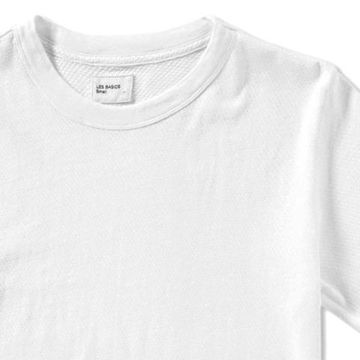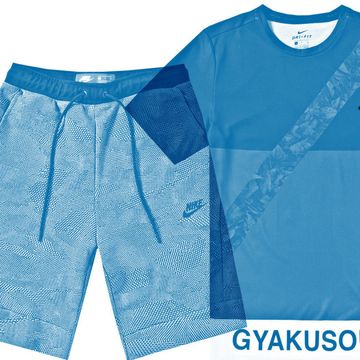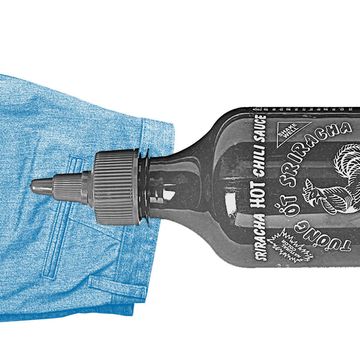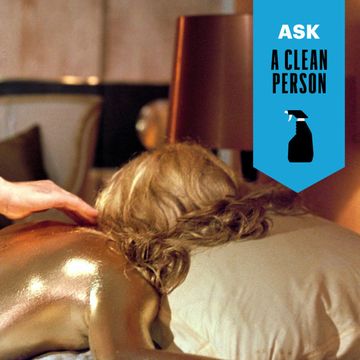It's starting to become that time of year again, sweater weather, so I'm taking all of my sweaters out of storage and I feel I should wash them before wearing them again. Do you have any recommendations about washing wool (merino, cashmere) sweaters in a high-efficiency machine? There's no shot that I'll be hand washing (delicate cycle!), but I'm not sure what detergent would be best; I've heard horror stories about Woolite but not much about anything else. Anything you can say to help?
I can say a whole bunch of things to help, and I will! Here's one thing I won't say: I'm not gonna tell you to hand wash your sweaters. I would love love love it if you would hand wash your sweaters, but you've made it clear that it's not a thing that's going to happen and so I'm not going to push it on you. I feel strongly that we're all adults here with free will; if you tell me that you can't be convinced to add hand washing to your laundering routine, that's absolutely fine. As for the rest of you, I'd like you to consider hand washing because it is truly the best thing for your sweaters and it's also a far less gruesome task than you might think, but I'll save that spiel for another day when one of you specifically asks about it.
Before we even get into the specifics of how to machine wash a sweater, what with all the fun to be found in discussing washing cycles and water temperature and laundry detergents and extremely exciting add-ons like protective baggies, allow me to take a minute to talk about how you can extend the time between washings and tell you about a tiny thing that made me clutch my proverbial pearls when I read this question.
Let's start with that pearl clutch-y thing, because it's fairly minor but well worth taking the opportunity to make a note about proper storage. The way our Letter Writer phrased his question led me to believe that when he put his sweaters away last spring, he just sort of folded them up and stashed them in storage. The problem is that, over time, any stains—even the smallest and barely noticeable of the genre—or build-up that's been left behind by skin, body oils, and/or deodorant, can cause permanent and irreparable damage to the fibers. Now, that's not to say that it will happen, just that it can. And since washing sweaters isn't super painstaking, I think it's worth doing so before they get put away to make room for your summertime duds.
The fact of stains and build-up brings us nicely to this next subset of our sweater-care discussion: Extending time between washing. The thing is about sweaters, whether they be cotton blends, or wool, or fine cashmere, is that they don't love being over-handled because of their tendency to pill, snag, and fray. Unfortunately, the handle-iest thing we do to our sweaters is washing them. The other handle-y thing we do is wear them, so don't get too unraveled over all of this. (You can go ahead and get unraveled over that really terrible sweater joke I just made, though.)
There are two separate things to know when it comes to extending the time between washing, and they basically come down to prevention and triage. Prevention is as easy as wearing something underneath, like an undershirt, to keep that aforementioned build-up from making its way onto the sweater. Over on the triage front, there is spot treating. It's exactly what it sounds like—treating spots, a.k.a. stains, as they happen rather than washing the entire sweater when a stain blemishes your fine woolens.
With those fundamentals behind us, let's talk about the actual washing. (I know you're like, "Good grief, lady, finally. Macaroni and Jesus, it took you a long enough damned time to actually, ya know, answer the question." AND THAT IS FAIR. But look, you learned some things along the way and if brevity is what you're after there are loads of cleaning experts who write in bullet points all over this great big Internet of ours. I won't be hurt if you seek them out.)
Detergent choice
The small act of pearl-clutching I engaged in due to a whiff of improper storage technique was nothing compared to the gasp of excitement I let out when I read that our Letter Writer knew of what I like to call The Woolite Mystery. Oh man, GET STOKED for this because it's so cool and weird. (OK, fine, my idea of cool and weird and yours are likely wildly different.)
So here's the thing you need to know first: There's a persistent rumor that is very, very, very often stated as fact on the Internet that Woolite is not only a bad detergent, but will out-and-out RUIN YOUR DELICATES. On the Internet, not only is the rumor stated as fact, it is also stated in ALL CAPS.
The story goes a little something like this: When Woolite was formulated, it was much gentler than competing detergents of the day. But, as detergent evolved and became more sophisticated, Woolite stayed the same and now, in comparison to today's detergents, is far too harsh for use on woolens and other delicates.
The problem, however, is that it's just not true.
You have no idea how good it feels to finally be able to say that with certainty. The reason I can do so, is that I asked Leigh Boerner, an expert in detergents who reviews those products for The Sweethome, to help me solve the mystery. And she did! Here's what Leigh had to say about the findings of her research on delicates detergents, "I remember you asked me at some point about Woolite and if it was really bad for wool. Now that I've tested it, I really don't think so. I took the pH of all the detergents I tested, since a basic [alkaline] solution can damage wools and cashmere and fun fibers like that." What she found was that the pH of Woolite, and almost every other delicates detergent she tested, is 7 (neutral) and so, in human terms, it's absolutely A-OK to use on delicates, wools, and other fabrics that don't benefit from exposure to alkaline/basic solutions.
Leigh added, "I think that the pH of detergents used to be a lot higher and perhaps Woolite's pH used to be higher as well? It's just speculation at this point, but I have a feeling that it used to be a problem but was fixed long ago, but 'Woolite is evil' remains in people's brains despite this. It actually cleaned very well, was one of the best."
So there you have it! Go ahead and get some Woolite, which has the benefit of being both easy to locate and inexpensive compared to other specialty detergents. The Sweethome will publish its guide to delicates detergent in January 2016, so you can (and should!) also make a note to keep an eye out for that.
HOWEVER! You don't actually need a specialty detergent. They're nice to have, to be sure, but not absolutely required. So if you would like to keep your laundering products as streamlined as possible, here's what you need to know. First, use a good laundry detergent. The difference in price-per-load between good detergents and less-good detergents is literally pennies, making it well worth the splurge. So, use your good detergent (need a recommendation? The Sweethome has you covered!) but use only a very small amount. A teaspoon to a tablespoon, depending on load size, will cover you. You do not want to over-detergent your sweaters, they don't like that.
Water temperature
Cold water, you guys. Always cold water for sweaters. When it comes to machine washing sweaters, water temperature trumps all other cycle selections. I mention this because some machines build certain water temperatures into cycles, while others give you the option of configuring water temperature separate of cycle type and length (more on that in a sec). If you have the latter type of washing machine great, stick with me. If you have the former, always always always choose whatever cycle uses cold water only.
Cycle type
The distinction in cycle types rests primarily in the speed at which the drum agitates whatever it is being washed. That lesson in sweater-handling I forced you to sit through now makes a whole bunch more sense, right? Right! Because you already know that you want to agitate your sweaters as little as possible, which is why choosing the cycle labeled "delicate" or "hand wash" is the thing to do. This cycle may also be expressed as "slow/slow"—what that means is that both the wash and the spin cycles are performed at the slowest speed at which the machine is designed to work.
Cycle length
Hey, and speaking of that lesson in not overhandling sweaters, here's one more setting for you to know about! If your machine offers a choice when it comes to cycle length, go for the shortest available option. Some machines express time in actual minutes (usually 4-15), while some use the far less transparent terms light, normal, heavy, or super heavy. Light is the one you want.
Protection
Can you stand one more directive on the subject of not overhandling sweaters? I'll make this quick, I promise! Using a mesh laundering bag will help to cut down on the amount of friction the sweater is exposed to. It's also best to wash the sweater alongside other delicate items and avoid putting it in the machine with heavy, bulky items like jeans, sweatshirts, and towels, which can rough-up more delicate clothes.
Drying
Air dry. Always air dry. Don't use the air dry setting on the dryer—too much friction. Just lay the sweater flat (hanging can cause the wet fibers to stretch) and let it air dry. You can speed things along by placing it near an open window, fan, or dehumidifier.
Now that you know more than you probably wanted to know about how to wash a sweater, there's just one more tiny thing to tell you about before I set you on your merry sweater-washing way. Even with the best care, sweaters will pill—that's the term for those little balls that show up when fibers begin to fray, break, and/or tangle. They're ugly, and you should have a tool with which to remove them. There are a bunch of different options, but the best of the bunch (according to me) is a battery-operated lint shaver, like this one made by KnitPicks. It's, like, four bucks. Well worth the splurge, especially after enduring the textbook on sweater care I just subjected you to. Sorry about that!













